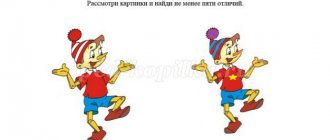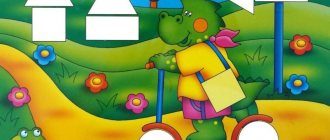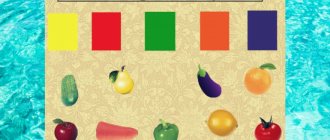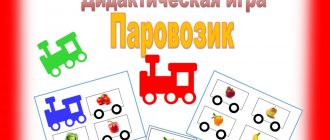Most early development methods give children only a general understanding of mathematics, which is limited to the skill of mental calculation and solving simple problems and examples. As a result, the child gets the impression that mathematics is a boring activity, far from creativity and the opportunity to show imagination. However, your child will probably look at mathematics “with different eyes” if you turn to Zoltan Dienes’ method for help.
Most early development methods give children only a general understanding of mathematics, which is limited to the skill of mental calculation and solving simple problems and examples. As a result, the child gets the impression that mathematics is a boring activity, far from creativity and the opportunity to show imagination. However, your child will probably look at mathematics “with different eyes” if you turn to the Zoltan Dienes method for help, which, unfortunately, is not as popular in our country as the Montessori method or the Waldorf system.
Let us immediately note that Dienesh’s method helps children not only master various mathematical concepts in an easy and interesting playful way, but also develop important psychological processes necessary for full and comprehensive development. Therefore, this technique can be used both as an independent training program and as an additional element of classes.
A few words about Zoltan Gyenes
Zoltan Pál Dienes has been interested in mathematics since childhood, so there is nothing strange in the fact that he decided to devote his entire life to the “queen of the exact sciences,” as well as its popularization not only in his native Hungary, but throughout the world. Already at the age of 23, Zoltan received a doctorate in mathematics, but did not rest on this and continued his education. In order to understand the mental processes involved in solving mathematical problems, he received an additional degree in psychology.
For most of his professional career, Dienes studied psycho-mathematics (for more than 10 years he headed the Center for the Study of Psycho-Mathematics at the University of Sherbrooke). Based on his own practical experience and the results of numerous studies, he developed a unique proprietary program for studying mathematics , accessible to children of various age categories.
Zoltán Dieneš's methodology is based on various logic games, exciting mathematical tasks and educational teaching aids aimed at stimulating children's interest in mathematics, as well as the development of combinatorics, logical thinking, analytical abilities, speech, memory and attention.
Features of the Dienesh system
Zoltan Dienes's method includes six interconnected stages of studying mathematics, which take into account the psychological aspects of solving mathematical problems.
The first stage is free play, during which children try to solve an unfamiliar problem by trial and error, trying out different solutions.
The second stage is studying the rules of the game, with the help of which the necessary mathematical information is “conveyed” to children.
The third stage is a comparison that allows you to diversify games with a similar rule structure with different materials, and thereby come to the understanding that changing the material does not change the essence of the game.
The fourth stage is familiarization with the content of numbers, thanks to which the child begins to understand the essence of the game and the common component of all mathematical games.
The fifth stage is symbolic, which includes the description of game cards using symbols, for which the child can come up with his own symbolic systems.
The sixth stage, formalization, consists of considering several options for describing game cards, as a result of which the child understands that the initial description can be an axiom, and his own conclusions can be a theorem.
Let us emphasize that Dienesh’s method completely excludes solving mathematical problems in notebooks or studying mathematical rules in boring textbooks. All activities are fun games, songs and dances during which children easily and quickly acquire mathematical knowledge and skills, and also get their first understanding of such complex mathematical concepts as algorithms, logical operations and information coding. At the same time, children, most often, do not even realize how complex concepts they are mastering in the course of exciting classes according to the “new mathematics” program of Zoltan Dienes .
Game index
At the beginning of the lesson, it is necessary to explain to the child what the didactic material is and how it can be used in the game. We pour the contents of the set in front of the baby and allow him to touch, look, and play. The child uses objects from the didactic set of Z. Dienesh in different ways in play activities: lays them out, replaces one block with another, rearranges them, hides them, finds them, distributes them among toy characters, etc.
Determining the properties of an object - games for the little ones
- A box for game elements can become an impromptu “house” with “windows” corresponding to the shape of the blocks. The baby will collect blocks through special holes with interest and excitement.
- We put the elements from the set into an opaque bag or fabric bag and ask the child to identify and name an object of a given shape by touch, justify his choice by voicing the sign, then take out the required block and make sure that the result is correct.
- We lay out all the game elements in front of the child and ask them to make a systematic selection by properties, sorting separately the blocks in the shape of a circle, square, etc., then, subject to the obligatory readiness and desire of the child, you can complicate the task by adding another feature, for example, color.
- A game of sequential chain, alternating blocks according to a certain logical criterion (color, shape or thickness). The task can vary variably, for example, first we ask you to continue the logical sequence in accordance with the pattern inherent in the exercise, or remove an extra object. The difficulty level of this task can also be gradually raised by adding new game conditions.
Video: game with Dienesh's logic blocks
Identifying properties and performing a comparison operation
- Game "Count and tell how many figures."
Purpose of the exercise: to develop the ability to correctly and accurately formulate a question, develop skills in determining the properties of objects, as well as comparisons according to various parameters.
Game scenario: Two teams of players participate. The teacher lays out multi-colored blocks of various shapes and sizes in random order and asks the children to ask questions that begin with the phrase “How many...?” Each correctly asked question receives one point, and the team with the most points wins.
Possible questions: “How many small blocks?”, “How many red figures in the second row?”, “How many blue thin figures?” etc.
The simplest logical task on the patterns of one property
Game for learning one property
Your child will be interested in putting together such figures on their own.
You can also use cards with geometric patterns
The children were told three properties of the shapes in order, starting from the first row. The child who had the required figure went out and placed his block in the right place on the Christmas tree.
The teacher plays the role of a conductor and gives the children tickets - geometric shapes. The same blocks are already on the bus seats. The guys need to find their seat according to the ticket.
The task of the hoop is to outline the playing areas for completing the task of sorting blocks
Blocks can be used to figuratively replace any object in a game fairy tale or literary plot, for example, a large yellow round block will become an appetizing jar of honey for Winnie the Pooh, and a child’s imagination can easily turn a yellow triangle into a goldfish.
You can invite your child to give gifts to his toys, for example, a bear will like round gifts, and a doll will like triangular ones, so you need to select only the necessary elements from the entire set. The game will become more interesting if new friends appear in it, for example, the bear has his little brother, for whom, accordingly, he will need smaller gifts, and the doll has a younger sister.
- Game "Little amateur gardeners"
Each player chooses a large shape (circle, square, triangle) of his favorite color, which will become his flowerbed. Next, he “plants” beautiful flowers, throwing shapes of different colors and shapes into the circle. Our flowers can share their fabulous story about themselves, which the child will come up with. The role of colors will be played by blocks (four properties) and figures (three properties), the quantity and quality of didactic material is discussed at the beginning of the game. For example, the presenter states the conditions: “In the flowerbed you need to grow three small, red, not round flowers,” or “a large blue rectangle, a large blue circle, a large blue square.”
Working with Symbols
- Game "Let's decorate the Christmas tree with balls."
There should be a total of five horizontal rows of three balls each. The number in the picture indicates the order in which the ball is positioned; we start counting from the top of the tree. An example of filling the second row. The first ball is a large red circle, the second is a small red triangle, the third is a large red rectangle. We place the remaining balls in the same way.
Sets of “Logical Figures” can be widely used by educators in the pedagogical process when familiarizing children with the standards of forms, teaching actions with standards
- Game "Match a Pair"
Goal: Improving the ability to visually memorize and retain information in memory, developing the ability to recognize and operate with symbolic cards.
The game involves twenty-two pictures with symbols without negation. All cards are randomly mixed and then laid out with their backs, six cards in each horizontal row. This leaves four in the bottom row.
The player turns over two independently chosen cards; if they are the same, he keeps them for himself, and then repeats his move. If the symbols of the cards are different, then they turn them over with the back side up and put them in place, trying to remember the image. All children carefully observe the manipulations with the cards, since the task of each player is to collect the maximum number of paired cards, and for this it is necessary to remember the location of the previously opened cards. Each child who enters the game repeats similar actions, the one who collects the most cards wins.
Video: educational games for children with Dienish blocks using a diagram map.
Games for systematization and logical actions
- Games with hoops.
To play the game, you will need colored ribbons or hoops that outline the area of the task so that two non-intersecting circles of different colors are formed on the floor. We explain the concepts of “inside” and “outside”. The child’s task is to place blocks of the corresponding color in each circle. The next task will relate to classification by shape, for example, we place only round blocks in a circle, and triangular ones outside. You can complicate the exercise by creating an area where the hoops intersect, thus creating three areas: left, right and general, in which the circles intersect. We ask the child to sort the blocks, for example, red ones should be in the right zone, all round ones should be in the left zone, and blue triangular ones should be in the general zone. Additionally, you can ask to place all non-red blocks outside the circles.
Formation of the operation of classifying blocks according to two, three, four characteristics using codes and without them. Determining intersection areas in hoop games. Development of logical thinking and attention
- Game "Baby Architect".
The goal is to develop skills in designing, decoding, reading diagrams and algorithmic maps. Additionally, you will need images of crossed out objects (“not properties”), drawings, diagrams or ready-made albums with pictures that consist of combinations of logical forms.
We draw a diagram (or take a ready-made one) to construct the building, ask the child to select building materials according to the instructions and complete the task step by step. For example, to build the first floor we will need three non-red rectangular elements, the second floor will consist of two non-yellow and non-round blocks, etc.
Video: developing concentration using Dienesh blocks (using the album)
- Game "Digital Mosaic"
The child takes a card with an example, solves it by decoding and selects the appropriate block. Then, for example, such a card means that he must take a red thick circle and place it on the tractor figure, covering the outline number six with a block.
How are classes conducted according to the Dienesh system?
Classes using the Dienesh method include:
- games with the so-called Dienesh blocks, among which there are tasks for children of various age categories. For example, for young children (about 3 years old), the game “this way - not that way” is ideal (figures of different shapes, colors and sizes are laid out in front of the child, among which he needs to find “such or not like” figures, in accordance with shown by an adult example). For older children, you can choose a game of translator, during which you need not only to find this or not such a figure, but also to explain how one figure differs from another.
- games with hoops - allow you to master and consolidate spatial orientation skills. To do this, parents place two (or more) hoops of different colors on the floor so that they intersect (like the Olympic rings). The child needs to place a figurine of a given format inside the blue... outside the red... outside the blue and red hoop. The more hoops, the more task options there can be.
- the fabulous country of Ruritania - the mischievous twins Alice and Bruce live there, with whom children have the opportunity to take part in fascinating stories and plunge into the world of geometry and algebra.
During the lessons, kids study geometric shapes and parameters of objects in a light playful way, acquire the skills of comparing and analyzing diverse information, create mathematical models, logical chains and series, and also learn to make the necessary decisions.
Games with Dienesha blocks in older preschool age
Children of senior preschool age are able to operate with several properties of an object at once. Children have developed imaginative thinking and are able to solve riddles, read symbols, engage in encoding and decoding. Preschoolers enjoy playing and doing exercises with Dienesh blocks. [ads1]
Game "Guess the riddle"
On a field of 4 or 5 parts, depending on the level of preparedness of the children, symbols of the figures are laid out, while the last window remains for guessing. For example, we put signs on the field: thin yellow and triangular. The child must place a thin yellow triangle in the empty window, and the size of the figure is not taken into account. You can make riddles from four symbols, for example: circle, thick, large, blue. In response, the child will put a blue, large, thick circle. The most difficult version of this game is with the negation of 1, 2, or 3 signs. The opposite game, “Make a Riddle,” is an empty tablet on which children, having chosen a figure, place the corresponding signs.
Educational game “Settling the Tenants”
The game “Settle the Tenants” is very exciting and students can play it in whole groups, and then test each other. In each apartment you need to place a tenant based on his characteristics (color, shape, size and thickness). For example, on the first floor there lives a blue, fat tenant, and on the second there is a red, not fat, but square tenant, on the third - not blue, rather large, round and thin. The houses are designed for children with different levels of preparedness, where it is necessary to take into account 2-4 signs and use negatives.
Educational game "Labyrinth"
Children happily respond to games like “Labyrinth”, “Tree”, etc., where they must find a place for their figure. Such games are aimed at developing the ability to classify blocks according to three characteristics and the ability to identify the main characteristics. Draw a tree with branches of different colors without leaves. Each branch has its own symbol indicating shape, size or thickness.
The child with the red large triangle must find a red branch with the “triangle and large” icon (or not a square, large, or a triangle, not small, etc.). It all depends on the level of development of the children and the creativity of the teacher. You can draw labyrinths, roads to garages, garden beds, and encode all information with icons. Such games bring great pleasure to children, and knowing about the “discoverer instinct”, you can achieve great results.
Educational game "Round Dance"
On winter evenings, and even on hot summer evenings, you can play dominoes or do round dances. To do this, divide all the blocks between the children and agree on the rules. The first player places any piece, and the next player must put a piece of a different size, or the same shape, but a different color, or a different shape, but the same size and thickness, etc. Children can come up with rules, and the teacher carefully monitors their implementation.
Disadvantages of the Dienes system
Strange as it may seem, experts did not find any shortcomings in Dienesh’s system . However, studying the reviews of parents who are already engaged in this system made it possible to identify such shortcomings as:
- Limited color variety in Dienes blocks;
- For older kids who solve more complex problems, one set of Dienesh blocks is sometimes not enough;
- The concept of “thickness” is incorrect, as a result of which it is sometimes difficult to explain to a child, for example, why a square is always flat;
- In Russia it is quite difficult to find albums for classes using the Dienesh system.
Subscribe to our Telegram to stay up to date with important news in the field of education.
What are Dienes blocks
This is the name of a special didactic manual for mastering mathematics, developed by a famous Hungarian scientist.
Zoltan Gyenes devoted his entire life to this discipline. He tried to make it as understandable and interesting as possible for children. For this purpose, he specially developed the author's Dienesh system for the early development of mathematics by children. The game manual is a set of 48 geometric shapes. They are represented by elements, among which there are no repetitions. The figures are divided according to the following criteria:
- Color. Blue, red, yellow.
- Size. Small, big.
- Thickness. Thick, thin.
- Form. Circle, triangle, square, rectangle.




